Samyang announced that they were going to produce some lenses for the Fuji X-Mount and that was good news to me, they have made quality lenses for DSLRS so I was interested to take a look at what they had to offer for the X-Pro 1. The first in a line of X-Mount lenses,the 8mm f2.8 fisheye is a smaller version of the lens used on DSLRS. The original DSLR lens is designed for an APS sized sensor, but I found it also worked quite well on a full frame camera if you removed the lens shade. I searched on the internet and did not see a lot of examples with the X-Pro 1, so I decided to rent one to give it a test drive. I have been using Lensrentals.com as my main provider for rental gear, they have been great to deal with and I recommend them highly. When I saw they had the Samyang 8mm fisheye in stock, I placed my order. I usually like to rent something before buying, especially if I am not sure I am going to really want it, also to test performance and quality. Sometimes I am just curious. Below are some images of the lens on my X-Pro 1.
Lensrentals.com had in stock one of the rebranded lenses. Samyang sells under their name, as well as being rebranded by Rokinon and other lens brands. The quality is the same. Samyang is a Korean based manufacturer that has some excellent optical quality lenses available for affordable prices. I have their 14mm f2.8 and 8mm f3.5 lens for Canon EOS and have been really pleased with the build and optical quality, the images have been really great from these two lenses. My only real issue with them is they lack the chip to transfer the information about the lens to the camera, so the camera does not know what lens you have on, or what the focal length, or what aperture is currently set. They do offer that for some Nikon lenses, I sure wish they would offer it for Canon! The Fuji X-Pro 1 is no exception, there is no communication with the camera. Luckily the X-Pro 1 allows you to set a focal length from the menu but you still do not get the aperture information. Bummer!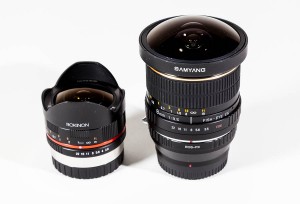
The Rokinon 8mm f2.8 for X-Mount arrived safely from Lensrentals.com and came with a small case to carry the lens. At first glance this lens is really tiny when compared to the EOS version. Pictured to the right is the EOS and X-mount versions compared side by side. The EOS version is mounted on the Kipon X-Mount to EOS adapter and the lens shade has been removed. I did this to allow it to be used on a full frame camera. Samyang now sells it with a removable shade. The build quality of the smaller cousin is up to the normal standard for Samyang. Well made and not cheap feeling. Th focus ring is smooth and the aperture ring has nice positive stops. The aperture ring is only in half stops and not thirds. The lens is nice and compact and about the same size as the Fuji 18mm f2 when compared side by side.
The electronic viewfinder is the best method of focusing and framing while using the X-Pro 1. The field of view is so extreme that you really do need to see what the sensor sees. This lens is considered a full frame fisheye, and this is full frame not in the sense of sensor size but the fact that the image is the equivalent of taking the largest rectangular image out of a spherical image projection. This gives an approximate 180 degrees field of view from corner to corner on a diagonal across the long side of the sensor and it does comes pretty close, but hard to actually measure. This means that if you are looking to do equirectangular panoramas then you will also need to shoot a nadir image and a zenith shot. Shown below is a 360×150 degree panorama flattened, the zenith and nadir were cropped because I did not take those images. So the edge to edge coverage across the long side is 150 degrees. Six exposures, taken with a lot of overlap and assembled in PTGUI. Of the sample images shown this was the only in which a tripod was used, along with a RRS panorama head. With careful calibration you could take the image as 5 exposures and include one up and one down for zenith and nadir coverage.
To view the above panorama as a virtual 360 panorama, you will need Quicktime, and click on this link: LB VR Pano
The fisheye distortion can be corrected in software, there are currently no lens profles available for this camera and lens combination but they might be available at some point. PTLENS, Adobe Camera RAW, and Lightroom will allow you to correct the distortion manually. Photoshop CS6 can also correct for fisheye distortion, that is a new feature with CS6. However the distortion can be interesting and can be used in an artful manner, so it is up to the photographer to decide what post processing is necessary.
The image quality is quite good and it can focus quite close with a huge depth of field. So manually focusing is quite easy and easy enough to just set an approximate distance and be quite sure that most all will be in focus. Like any uber-wide angle lens, shooting it wide open at f2.8 and also because of the fish eye distortion, the corners of the image can be a little soft but it is totally usable and stop it down a bit and you won’t notice. The lens coatings seems to handle flare pretty well, although with something this wide it is hard not to get some flare. Color and contrast are good.
The extreme wide angle can also create some other “issues”. I normally hold the camera with my right hand over the shutter and gripping the camera while my left hand cradles the lens so that I have fast access to the focus and aperture rings. While using this lens you have to be careful as I found I was often getting my knuckles and part of my hand in the shot! Also while holding the camera, especially in the portrait orientation, tilting the camera down slightly often caused me to get my elbow or my feet in the image. So you really need to scout around the viewfinder and look at the whole frame before pressing the shutter button.
So is it worth buying? I would say yes. It is certainly not a “must have” lens but it is an interesting lens with a novel effect which can be used quite creatively. It can also be used to create stunning virtual tours using an appropriate panorama head on a tripod. Price is reasonable and the build quality is good, so if you are in the market for a specialty lens like this, I would definitely get one.
Below are some sample images. The interior shots of the church are taken with the camera resting on the pews at very high iso with bracketing. When the light is so low and shutter speed gets down to 1/30 of a second the camera will bracket using the ISO, when in autoISO mode, so that can be useful. The highest ISO used was 6400. The other building shown is the Pasadena City Hall, one of my favorite buildings to photograph. I did not do any distortion correction in the sample below. Click on the thumbnails to see slightly larger versions you can also take a look at this same set of images on Flickr: 8mm sample images

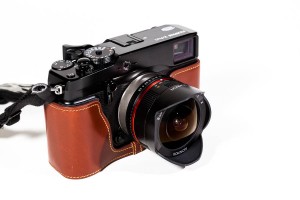
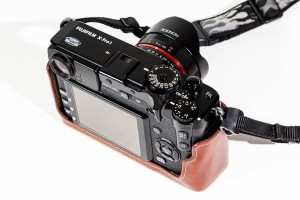
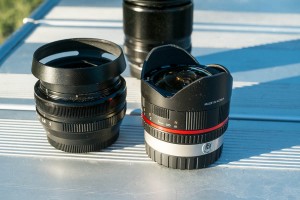
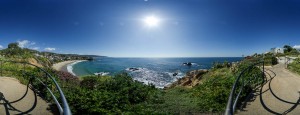
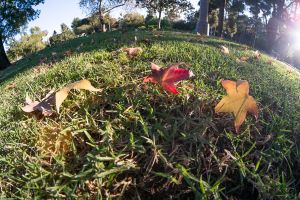
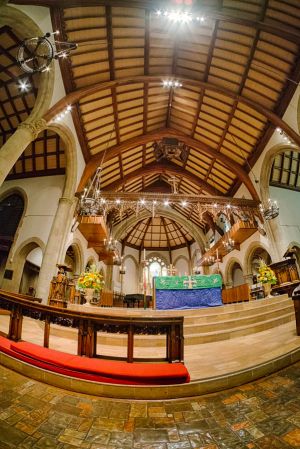
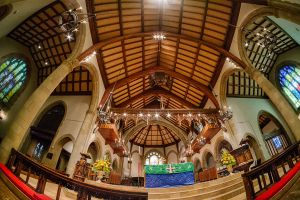
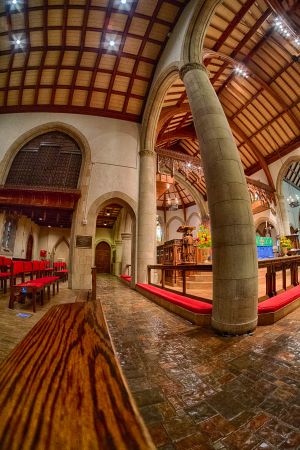
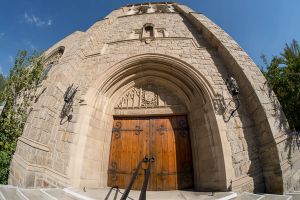
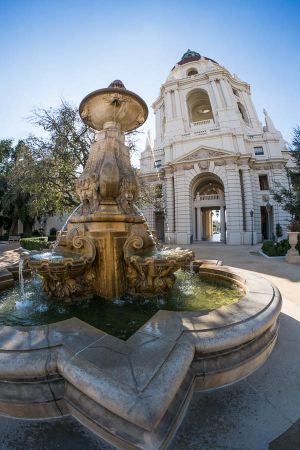


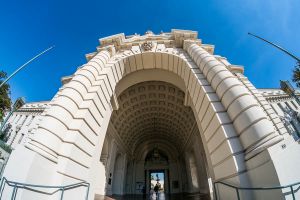
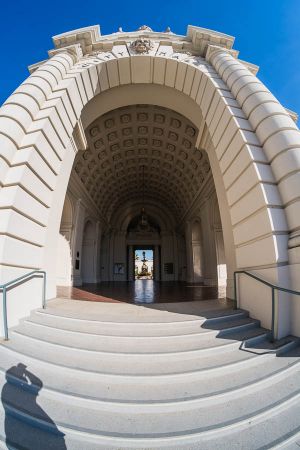
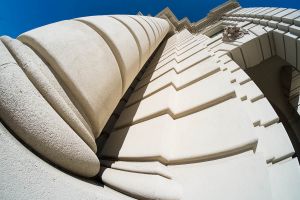
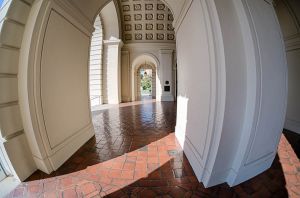

5 Comments
Did you used AE Bracket for the panorama you’ve made?
The shots used to make the panorama are single shots at each position. The camera was mounted on a panorama bracket that allowed the camera to sit at the entrance pupil or nodal point of the lens and rotate. The panorama was assembled in PTGUI, from the out of camera jpegs.
Thanks for the review! Is the lens shade on the version for x- mount also removable?
Thanks and glad it was useful. The lens shade is not removeable. It is fixed.
I have been intrigued for a while about the several Samyang (or other brands under which they are sold) 8mm lenses.
In the introduction above you equate the 8mm 2,8 to the 8mm 3,5 .
“……At first glance this lens is really tiny when compared to the EOS version. Pictured to the right is the EOS and X-mount versions compared side by side…..”
I believe that the two lenses are so different in shape because they are simply not the same.
Samyang 8mm f/2.8 UMC Fisheye 10 elements / 8 Groups (1 Aspherical, 2 ED)
Samyang 8mm f/3.5 Aspherical IF MC Fisheye 10 elements / 7 Groups / 1 Aspherical lens
and despite their similar or equal focal length ( the f 3,5 version is sold by other brands as being a 6,5mm or a 7mm!) every image that I have seen showed that the 2,8 version gives much more “ curved” pictures than the 3,5.
I would have appreciated a side by side comparison between the two lenses since you have or have had them both.
Cheers!
3 Trackbacks
[…] A look at the Samyang 8mm f2.8 fisheye lens on the X-Pro 1 | Alan P. Samllbone From https://www.aps-photo.com – Today, 9:25 AM […]
[…] PS.: This year Santa Claus comes with a Samyang 8mm lens for the Fuji X-Pro1. See the shots here. And for another review with the Samyang 8mm click here. […]
[…] Samyang announced that they were going to produce some lenses for the Fuji X-Mount and that was good news to me, they have made quality lenses for DSLRS so I was interested to take a look at what they had to offer for the X-Pro 1. The first in a line of X-Mount lenses,the 8mm f2.8 fisheye is a smaller version of the lens used on DSLRS. The original DSLR lens is designed for an APS sized sensor, but I found it also worked quite well on a full frame camera if you removed the lens shade. I searched on the internet and did not see a lot of examples with the X-Pro 1, so I decided to rent one to give it a test drive. I have been using Lensrentals.com as my main provider for rental gear, they have been great to deal with and I recommend them highly. When I saw they had the Samyang 8mm fisheye in stock, I placed my order. I usually like to rent something before buying, especially if I am not sure I am going to really want it, also to test performance and quality. Sometimes I am just curious. Below are some images of the lens on my X-Pro 1. Lensrentals.com had in stock one of the rebranded lenses. Samyang sells under their name, as well as being rebranded by Rokinon and other lens brands. The quality is the same. Samyang is a Korean based manufacturer that has some excellent optical quality lenses available for affordable prices. I have their 14mm f2.8 and 8mm f3.5 lens for Canon EOS and have been really pleased with the build and optical quality, the images have been really great from these two lenses. My only real issue with them is they lack the chip to transfer the information about the lens to the camera, so the camera does not know what lens you have on, or what the focal length, or what aperture is currently set. They do offer that for some Nikon lenses, I sure wish they would offer it for Canon! The Fuji X-Pro 1 is no exception, there is no communication with the camera. Luckily the X-Pro 1 allows you to set a focal length from the menu but you still do not get the aperture information. Bummer! …. […]